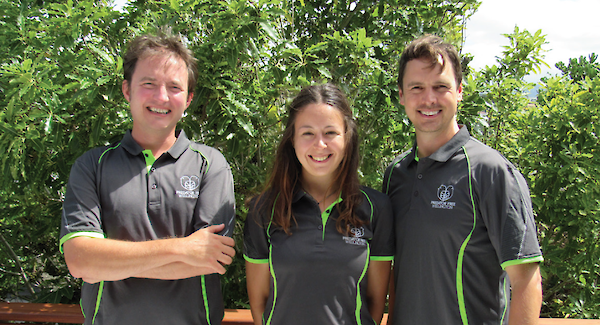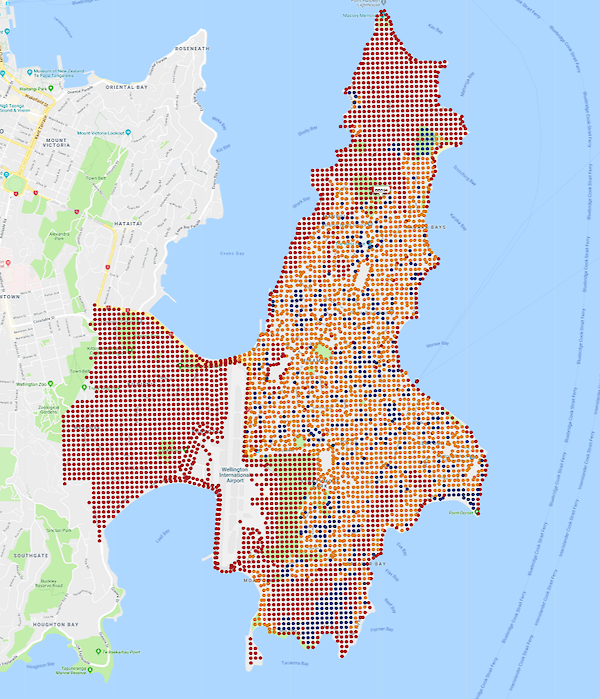After thousands of conversations we’re almost there!
The first stage of our wider plan to make Wellington city predator free kicked off this year with Miramar Peninsula.
Our three community liaison officers, Emma, Phil and Joakim have been out on the peninsula every day, walking the streets of Miramar, Seatoun and Strathmore, speaking with the community about how they can be involved in the project.
 The team have now had thousands of conversations with households, schools, community centres and businesses and the response has been overwhelmingly positive with people excited at the thought of having kākā, ruru, kārearea and lizards as common garden visitors, as well rats out of their homes.
The team have now had thousands of conversations with households, schools, community centres and businesses and the response has been overwhelmingly positive with people excited at the thought of having kākā, ruru, kārearea and lizards as common garden visitors, as well rats out of their homes.
It’s amazing how many people are beyond frustrated at having rats making noise in their roof, or doing expensive damage to pipes in their walls, so the motivation for becoming predator free is for many different reasons.
There have been some great stories from people who have lived on the peninsula for decades and who watched birds disappear as the pests increased, but are now gladly watching them return. Some have said they are thankful to see their grandchildren grow up in a place where seeing tuī is now a normal part of everyday life. Others have watched the native geckos in their garden shed gradually disappear and want to make sure they are protected. We’ve heard people say things to whānau like “Oh, that’s why we are seeing pīwakawaka (fantails) again! It’s because of Predator Free!”, so people are noticing things changing already.
The eradication method we will be using on the peninsula is similar to what was used to make the peninsula possum free.
 We are working to a grid of 50m x 50m bait stations and 100m x 100m traps. Needing to work to a grid can be challenging for the team at times, especially if we are unable to make contact with people or people do not want to be part of the project. When this happens we try to remain within the grid, by moving it onto a neighbouring property where we can. It can also a challenge to place the unit in a discreet area, but also a good area where rodents are likely to be.
We are working to a grid of 50m x 50m bait stations and 100m x 100m traps. Needing to work to a grid can be challenging for the team at times, especially if we are unable to make contact with people or people do not want to be part of the project. When this happens we try to remain within the grid, by moving it onto a neighbouring property where we can. It can also a challenge to place the unit in a discreet area, but also a good area where rodents are likely to be.
We are getting there though, by the end of this month we hope to have 3,000 households and businesses agreeing to host a trap/bait station.
One of the common questions we receive from the community when they’re deciding whether they want to be part of our project, is how will it affect their pets? Safety of pets has been prioritised throughout every aspect of our project planning. The bait stations are designed to prevent pet access. The bait will be carefully placed in locked bait stations keeping the bait secure and a key is required to get to the bait.
In the very unlikely event that a pet did gain access it would need to consume the contents of several bait stations before becoming ill. For example a 15kg dog would need to eat at least 10 bait stations. Cats are not attracted to the bait. If the unthinkable did occur and a pet ate enough bait, there is an antidote and it could be treated with Vitamin K. The traps we are using are placed in long protective boxes with small entrance holes to prevent any interaction with pets.
If you would like to know more about the operation check out our Miramar 2019 page.
Infrastructure will be installed in June and July, and by the end of the year we will be looking to verify zero rats, stoats and weasels on the peninsula. In this final stage we will using sniffer dogs to help us sniff any last predators. We will also be monitoring for new wildlife turning up.
Posted: 26 May 2019
